#August Piccard
Text
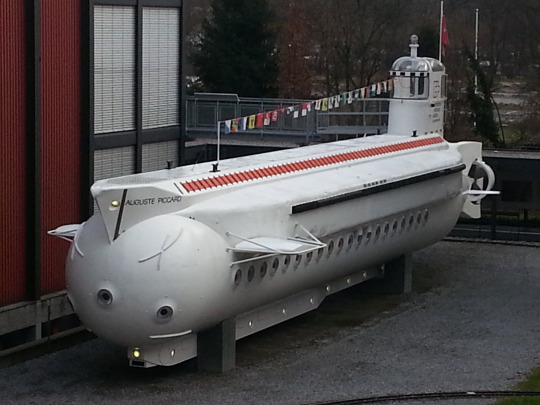

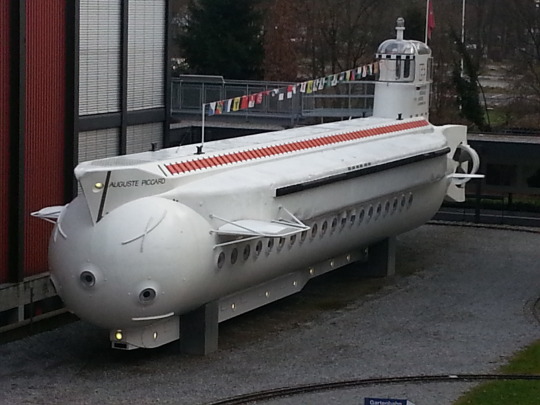
National Submarine Day
Pay tribute to the many souls lost beneath the ocean, and consider the game-changing effects of the invention of the Submarine on our technology, warfare, and more.How low… can you go? How low… can you go? When it comes to National Submarine Day, it’s easy to believe that it’s pretty low.
History of National Submarine Day
Some people may find it hard to believe that the first recorded submersible was built by Cornelius Drebbel in 1620! This underwater ship was apparently built for James I of England for use in London, although why anyone would want to plunge beneath the surface of a 17th century Thames is difficult to understand!
The original versions of submarines were built to hold only one or two passengers, but modern versions are made to hold up to 100 passengers. Typically, since this is a very dangerous job, militaries will use as few people on their crew as possible.
April 11, 1900 is the date when the United States government purchased its first commissioned submarine, named the USS Holland. The USS Holland was the United States Navy’s first commissioned submarine, named for her Irish-American inventor, John Philip Holland. (It is important to note that this was not actually the first submarine of the US Navy, which was the 1862 Alligator.) But this boat was originally laid down as Holland VI, and launched on 17 May 1897.
Having played major parts in military operations for over a century, today’s submarines are, of course, far more sophisticated than that particular oar-powered contraption. The amount of expertise that goes into their design, construction, maintenance and operation is quite staggering, especially when you take into account the inclusion of navigation and communication networks, sensors, armaments and weaponry, and powerful propulsion systems. This is all in addition to the most important part of a submarine: a large number of rigorously trained and highly skilled men and women who are often putting their lives on the line for their countries!
In honor of that first commissioning of the USS Holland in 1900, National Submarine Day was established to be celebrated each year on the anniversary of this date!
How to Celebrate National Submarine Day
Today’s observance of National Submarine Day can take on many forms. Here are some ideas for making plans, but feel free to go far beyond and get creative with some of your own ideas too!
Visit a Submarine
Those who are serious about observing National Submarine Day might want to consider taking a road trip to a museum or other exhibit where a submarine is accessible to the public. Smaller retired subs often find themselves put on display for adults and children to see and experience what it is really like, in places like children’s museums and science exhibits.
Various submarine tours can be found in port cities in the United States and other countries, including Australia, Canada, the United Kingdom, Denmark, and many other European countries.
Learn Fun Facts About Submarines
In celebration of National Submarine Day, raise awareness for the day by learning about and sharing some of these interesting bits of trivia:
Submarines were used in the American Civil War. The South built small steam-powered subs called “Davids” to fire torpedoes at the ships from the North.
The furthest dive completed by a submarine was 35,858 feet.
The world’s first submarine for the military was designed in the US and built in 1776, the same year the US gained its independence.
The periscope, which is a vital tool for submarines, was invented in 1854 by a Frenchman.
Check Out the Submarine Force Library & Museum
In the US, the only submarine museum in the country that is run by the US Navy is located in the New England state of Connecticut. At the Submarine Force Library & Museum, the first nuclear powered submarine, the USS Nautilus, resides right outside the back doors of the building. Free tours of the sub are given for individuals, families, school trips and more. Scavenger hunts are also a fun way for folks to participate, especially in celebration of National Submarine Day!
Take a Moment to Consider Submarines
In celebration of National Submarine Day, perhaps it would be important to simply take some time to think about and consider this special feat of engineering. Take a moment to think about the ingenuity and majesty of the mighty submarine itself. Celebrate its place in the modern world. Or imagine what these submarines might be like in a hundred years’ time!
But perhaps most importantly, this would be an important time to take a moment to think about those whose lives have been lost at sea over the years and pay tribute to the courage of those who made a sacrifice, whether in the name of their countries or for increased knowledge and science.
Source
#Mesocaph#August Piccard#Verkehrshaus der Schweiz#Swiss Museum of Transport#Luzern#Lucerne#Switzerland#tourist attraction#landmark#technology#engineering#Copenhagen#København#Denmark#Atlantic Ocean#National Submarine Day#NationalSubmarineDay#11 April#travel#vacation#Europe#summer 2006#original photography#cityscape#architecture
3 notes
·
View notes
Text
Auguste Piccard, le vrai professeur Tournesol
Nouvel article publié sur https://www.2tout2rien.fr/auguste-piccard-le-vrai-professeur-tournesol/
Auguste Piccard, le vrai professeur Tournesol
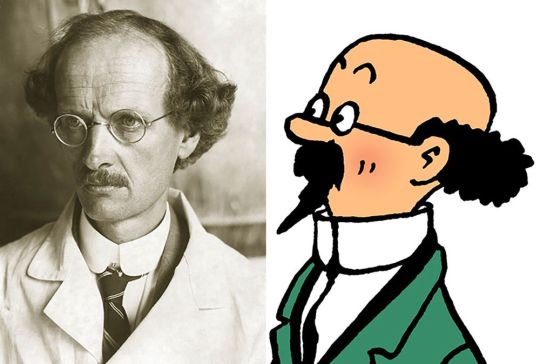
#20eme siecle#Auguste Piccard#bathyscaphe#explorateur#herge#inventeur#savant#tintin#Tryphon Tournesol#vidéo#people
3 notes
·
View notes
Photo

Профессор Пикар перед отлетом в стратосферу. Бесстрашный ученый, выглядывая из окна гондолы, отдает последние распоряжения. С первыми лучами солнца шар унесет своих пассажиров в невероятное приключение, предпринятое во имя науки.
10 notes
·
View notes
Text
MANUSIA PERTAMA YANG MELIHAT BENTUK BUMI DARI STRATOSFIR (1931)
Auguste Piccard Melalui lubang intip, para pengamat melihat bumi melalui kabut berwarna tembaga, lalu kebiruan. Tampaknya piringan datar dengan tepi terbalik. Pada ketinggian 10 mil, langit tampak biru gelap pekat. Setelah pengamatan selesai, pengamat mencoba turun, tapi tidak bisa. Sementara tangki oksigen mereka kosong, mereka melayang tanpa tujuan di atas Jerman, Austria, dan Italia. Udara malam yang sejuk mengontrak gas balon dan membawanya turun di gletser dekat Ober- Gurgl, Austria, dengan cadangan oksigen selama satu jam.
Selengkapnya klik disini.
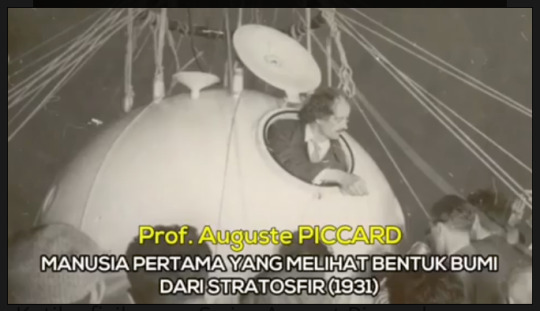
Sepuluh Mil tinggi dalam BALON KEDAP UDARA.Profesor Piccard, di tengah, duduk di dalam bola, mempelajari instrumen sebelum pendakian yang berani. Di atas, membongkar balon di gletser yang tinggi.
#Auguste Piccard mengatakan bahwa ia telah melihat bentuk bumi yang sebenarnya#Inilah ungkapan Auguste Piccard yang sebenarnya#Auguste Piccard dikatakan dia orang pertama melihat bentuk bumi#Benarkah Auguste Piccard orang pertama melihat bentuk bumi
0 notes
Text
Auguste Piccard orang pertama melihat bentuk bumi tampak terlihat piringan datar dengan tepian terbalik
Piccards: Sampai ke Ujung Bumi (1931-1997).Ringkasan Plot.
Ketika fisikawan Swiss August Piccard merancang sebuah balon dan naik ke stratosfer, dia menetapkan tanda ketinggian baru di dunia.
Perjalanan enam belas jam dari Jerman ke Austria pada tahun 1931 adalah penggunaan pertama kabin bertekanan untuk penerbangan berawak. Tiga puluh tahun kemudian, dia dan putranya Jacques merancang balon…

View On WordPress
#Auguste Piccard orang yang melihat bentuk bumi yang sebenarnya#Inilah penjelasan Auguste Piccard setelah melihat bentuk bumi#Orang pertama melihat bentuk bumi adalah Auguste Piccard
0 notes
Text
Interview with Dawn Riley, 1 April 2024
KaiYves (KY): Hey, everyone, my name is KaiYves from A Solitary Sea Rover, and I’m here with Dawn Riley at Oakcliff Sailing Center, an incredibly famous veteran of offshore sailing. You were in the Whitbread twice, I think?
Dawn Riley (DR): Uh-huh.
KY: Which is now The Ocean Race, in 1989 and then 1993, and then the America’s Cup in 1992, 1995, 2000, 2003, 2007…
DR: 2003, I did the easy part, I was media. (laughs)
KY: And you were in management for–
DR: For 2007, yup.
KY: And today you’re the head of Oakcliff Sailing Center, since 2010, I think?
DR: Yup, absolutely.
KY: And you’re also, as of last year, in the America’s Cup Hall of Fame.
DR: Yes, I’m a triple-famer. America’s Cup Hall of Fame, National Sailing Hall of Fame, and then the Michigan Sports Hall of Fame. So three different organizations, all honoring sailing.
KY: And it only took 30 years.
DR: (laughs) Yeah.
KY: And now there’s four women in the America’s Cup Hall of Fame!
DR: Yup.
KY: …and forty men, right? (laughs)
DR: I have not done the math, but yeah, there’s more men than women across the board. [It's actually more like 100 men and 4 women.]
KY: It’s reflective of the event. So we met at the 12-Metre World Championships last summer in August, that was an incredible weekend, you know, just the level of access there was, being able to walk in and see everyone, being able to see the boats, and photograph them. I was able to help out a little bit.
DR: Yup.
KY: Because you guys needed a phone charger. You let me come on the chase boat, that was incredible, I got to see [the racing] up close… I got kind of seasick, but I still had a wonderful time.
DR: (laughs) Good to know.
KY: And then I helped hose down a little bit afterwards. So I was joking with my friends that I can tell everyone that I was a 12-Metre crewmember for five minutes.
DR: There you go. (laughs) And Courageous is a pretty special yacht.
KY: I said to my friend, “You know, this summer I was a crew member on Ted Turner’s yacht. There’s a lot of clarifiers to that, but…”
DR: (laughs)
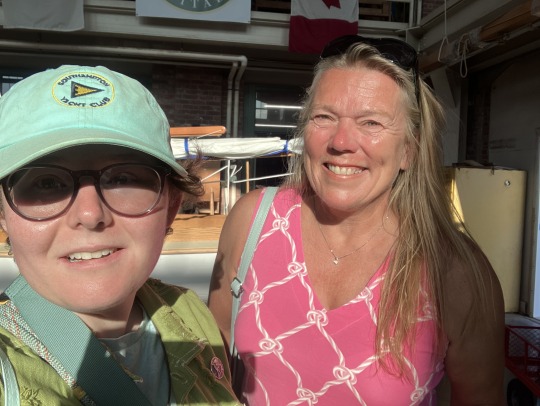
At the 12-Metre Worlds.
KY: In a very loose sense I was, yes. You agreed to do this interview with me and let me come visit and I’m super excited for that. I got my Master’s at NYU and a few weeks ago, I was in Greenwich Village. So I went into the Strand Bookstore, the famous bookstore there, for old time’s sake. I was looking around, I was in the basement stacks, looking at the travel, exploration, transportation sections, and while I was there, this is what I found– (pulls out a book wrapped in cloth from her backpack and unwraps it to show it’s Riley’s book Taking the Helm)
DR: Ah. Taking the Helm. (takes book to examine it) Is this one signed?
KY: Oh, yeah, it is.
DR: I think I signed almost all of them.
KY: So I don’t have to bother you for that.
DR: There you go. (laughs)

This is the softcover cover, mine looked slightly different.
KY: I thought, “This is great”, because I’d already made the arrangement to talk to you, “This is a good omen, I think”. It also has this flier from back in the day. (unfolds a paper flier tucked into the dust jacket and hands it to Riley)
DR: Oh my goodness, this is funny. Yup, this was the promo that I sent out. I put together this flier myself and it was to try and do speaking. That’s crazy, I haven’t seen that in for-ever.
KY: Do you want to keep it?
DR: Um, sure. I don’t think 1-800-511-DAWN works anymore, but I’ll check.
KY: You find some really great things at Strand, you know. I found, um, Bertrand Piccard, who went around the world in the balloon, I actually found a signed copy of his book about that at Strand.
DR: Mmm-hmm, OK.
KY: I found a book about the ‘77 America’s Cup that had a newsletter from the ‘83 one inside of it and I said, you know, “I think the flier might be worth more than the book, but…”
DR: (laughs)
KY: So used bookstores are amazing.
DR: Hmm-hmm.
KY: But I was really excited [to read your book] because it was actually the third book I had read about that era of the Round-The-World Race in the past year. I’m working on a fictional story that’s about a fictional team in the 80s in the Whitbread, so I’d read a few different books. I’d read Peter Blake’s book about Ceramco in 1981, I’d read Skip Novak’s about Drum in ‘85– I think you have most of those out there [on the bookshelf in the main room]. And so, I wanted to see and contrast the different people’s voices and so forth. I know I contrasted those [two] as I was reading. I thought, you know, Blake had this very fun, optimistic sort of voice where it’s all this very jolly adventure.
DR: Peter Blake was a good friend of mine. He was an amazing seaman. He and his wife were adventurers. And unfortunately, tragically, he was killed on an adventure in the Amazon. But he was probably one of the most solid and most revered New Zealanders out there.
KY: It was a great book, you know, just this good humor throughout. Whereas Skip Novak’s, it’s a lot more gritty and cynical. He’s talking about people fighting each other, talking about people doing unsanitary things and stuff like that. And I actually thought, just, the way the book opens, where they come into Cape Town really early in the morning and nobody’s there to greet them because they’re sixth, it’s just the officials. And they spray them with champagne and he’s like, you know that’s always the cheap champagne and it makes you sticky and it’s nasty. And he’s like, and now we’re in Cape Town, it’s 1985, and there’s all of these signs that say, ‘No Black People [Allowed] Here’. And so, he’s just very much showing the grittier side of his experience.
DR: Or, more, just the pessimistic side. Knowing Skip, that’s his personality.
KY: Yes.
DR: So both of those people’s personalities come through.
KY: But he also in the end enjoyed this adventure and he still thought it was worth it. So I liked having those two different perspectives. And so I was curious to see, when I read your book, how your perspective compared. And I think you have more of an optimistic voice.
DR: I am eternally optimistic. If I wasn’t, I would not have made anything of my life, because everyone told me I couldn’t. I said, “Oh yeah? Screw you, watch me.” So I’ve been forced to be, but luckily eternally optimistic. Which doesn’t mean I am a Pollyanna. So I’m realistic and prepared as well.
KY: I mean there were some, you know, gritty details, but I thought that it was, overall, more of a “Blake” sort of voice. But what I thought that was in your book that was not really in the other ones was a lot more about emotions and familial connections. And just talking about the people back home and everything. Which is something that made it kind of different. And some really beautiful language.
DR: So I have to have joint credit for that with Cyndy. I kept a running [log], I wrote it during the race and then she cleaned it up. And went back and forth and back and forth on the editing. So it was absolutely a joint editing process. And sometimes my language was way too flowery and she’d bring it back down, and sometimes hers was a little too professional and I’d be like, “That doesn’t sound like me!”, so I’d bring it back.
KY: I love when you’re talking about how you left South America and you were under a sky full of diamonds, going out into a sky full of diamonds.
DR: Yeah, there’s… It was just a couple of years ago, now, so it’s 2024… before COVID, so say 2018, I was down in Florida on a beach… (a phone in the office rings and Riley stops to press a button to silence it) I walked down to the beach at a party and there was nobody else around. I looked up at the sky, I was like, “This is what I miss. I miss being out there.”
KY: I mean, it must be, it’s some of the darkest skies on Earth when you’re in the middle of the ocean.
DR: Yes, of course, you’re out– there’s some points, and I think this was described in the book, some points where you can’t really tell where the sky ends and the water starts. ‘Cause it’s just a circle.
KY: And I loved that. Because I feel like a lot of the time, when you read books from people who did something really interesting, their skills are not in writing so they describe it very simply.
DR: Uh-huh.
KY: And I’m like, okay, so you flew around the world or you climbed Mount Everest, but I don’t really get a sense of what it was like for you. But with you, I did.
DR: Okay, good.
KY: And what I also liked about that book was that I was able to see connections because I’ve read a lot of other books from the same time period. Because I go to used bookstores and people give away their books about twenty-five years afterwards. So, I was like “Oh!” At the same time [you were racing the Whitbread], there was the ENZA trimaran going for the Jules Verne Trophy, which I had read— actually, just the year before— read Cam Lewis’s book about Commodore Explorer.
DR: Uh-huh.
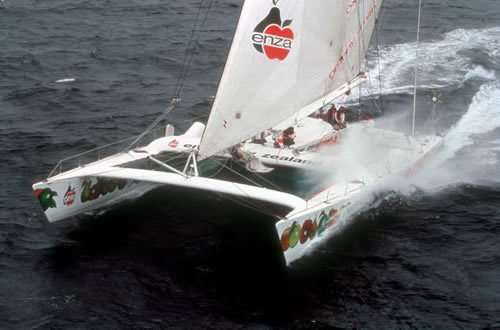
The Jules Verne Trophy, not quite like the book. [x]
KY: And then, at the same time you were planning for the America’s Cup 1995. And during lockdown, I actually read Anna Huntington’s book Making Waves.
DR: Yup.
KY: That’s always, to me, a very particular experience reading that book, because I got it from Breakwater Yacht Club, I borrowed it just before lockdown and then I had it. There was nothing else to do so I just was biking around in the spring. And I went to this little beach in North Sea and I just sat down on the beach and I was just reading this book and trying to think about something– just something else because it seemed like the world was going crazy. And there was an osprey family up in a nest. And it was just me, and the osprey, and this book about the America’s Cup.
DR: Uh-huh.
KY: So you’ve made a home here [on Long Island] in our area, but you’re from Detroit, originally.
DR: Yup.
KY: And you learned to sail there?
DR: I learned to sail with my family. No formal training, no junior sailing type of training, but my dad was a sailor and a racer and he would basically, I think… My mom would say, “Take one of the kids, get out of the house!” So I got to go, because I was the oldest, which was pretty cool. So I think the first sailboat race that I did, for sure, the first one that I can remember, I was about four years old. And they did a crash gybe, and I got rope burn under my arm, and I thought it was amazing. My mom wasn’t so happy. But they also did not put limits on it. So I started racing on bigger boats in the– in the 70s, Jesus.
KY: So did you have, at that point, heroes as a kid that you looked up to in the world of sailing?
DR: When you’re that young, the only peers you have, the only people you know about, are your family. When we came back from sailing for a year, on the year’s cruise, I obviously had my eyes opened by seeing all the different places and all the different jobs in the industry. From, you know, powerboat captains to workers, to engine repair, to riggers in the Caribbean. You know, all of that just exposure, Antigua Race Week… hippie yacht captains, Jimmy Buffett, Ted Turner, who we met on the dock, a sailboat racer with TV cameras following him… so that was a whole exposure. And then when I got back, and started racing, the people in the industry, the professionals in the industry, were my role models. Sailmakers and boat workers, boat captains.
KY: And this was the year that your family went to the Caribbean, you said?
DR: Yup, we did that when I was 13, so I started working and being paid to work on boats when I was 15, and put myself through college doing that.
KY: That must have been incredible, just being with your family in the Caribbean like that and going from place to place.
DR: Uh-huh. Yup, it was very organized and scheduled. Lots of sailing events. We went as far as you could, I think as far as you possibly could on a 56-foot wooden boat in one year and seven days. Because we had an extra week. My dad had two leaves of absence, but he worked for a week in Puerto Rico to make it up. So one year and seven days from the time we departed to the time we got back. We were on a schedule, we rarely stayed in the same place more than one night at a time. So it was pretty cool.
KY: When you were growing up, as a teenager and so forth, what was your awareness of the America’s Cup and then the offshore sailing?
DR: My awareness of the America’s Cup was discovered during that year’s cruise. When we were in Newport, in ‘77, the trials were going on. And then, I didn’t really know about the Round-The-World-Race because there had been no stopover in America until the race we did. But when I came back, at North Star Sailing Club, on Lake St. Claire, there was a film on the Whitbread, and I’m like, “Oh! I want to do that!”
KY: You were a teenager when you decided you were going to do that.
DR: 15, yeah. Maybe 16. Probably in winter. 15 or 16, it doesn’t matter.
KY: But that was your moment. And you followed on that course to become a professional from that point on?
DR: Well, professional back then wasn’t really a word. You were a boat captain. The professional/amateur only came into it in the 2000s when there was a marketing push from the Farr office that was building boats and started saying, you’re professional, you’re amateur. And I kind of got a little bit screwed over in that. Thank God I had enough time before people discriminated against professionals. Because we were poor and we needed to work to be able to sail. And I was able to get my skillset up. But basically, as I wanted to go sailing, I needed to eat and I needed to pay for college. So I had a job working on boats and sail lofts and cleaning boat bottoms and making sandwiches and anything I could do to keep those two things. I wanted to sail, I needed to eat, oh yeah, and I needed to pay for college.
KY: And you had the aspiration to go as far as you could?
DR: No, I wanted to do the America’s Cup and I wanted to do the Round-The-World, but I also thought maybe I wanted to go to the Olympics. And I also thought I wanted to be an advertising executive on Madison Avenue. So I kept a lot of different goals and I didn’t really know that it was a possibility to continue in the sailing until I didn’t get a job in advertising. And then I was ready. So what I tell people here at Oakcliff is that you absolutely have to have a plan. And whether it’s going to be school, family, real job, business, boatbuilder starting a business– but you always have to have your seabag packed and ready to go when an opportunity presents itself. And that’s kind of what I did.
KY: I’ve actually (laughs) I’ve actually had the worst luck trying to watch the Maiden documentary. There’s been places that I’ve been where it was showing and I kept missing it. And I got the DVD now and I was trying to watch it last night and my computer is new and I hadn’t set up the DVD program, and so I only got to watch, like, the first half-hour.
DR: Oh, bummer.
KY: So I’m sorry I can’t ask you too many questions based on that.
DR: It’s okay. I will tell you that the movie is quite realistic. And they were talking about trying to make a Hollywood remake of it, and I don’t know how that would be possible. Because the footage was so good, the story was so well-done, and the only thing you could add to make it more Hollywood, honestly, would be romance. (laughs)
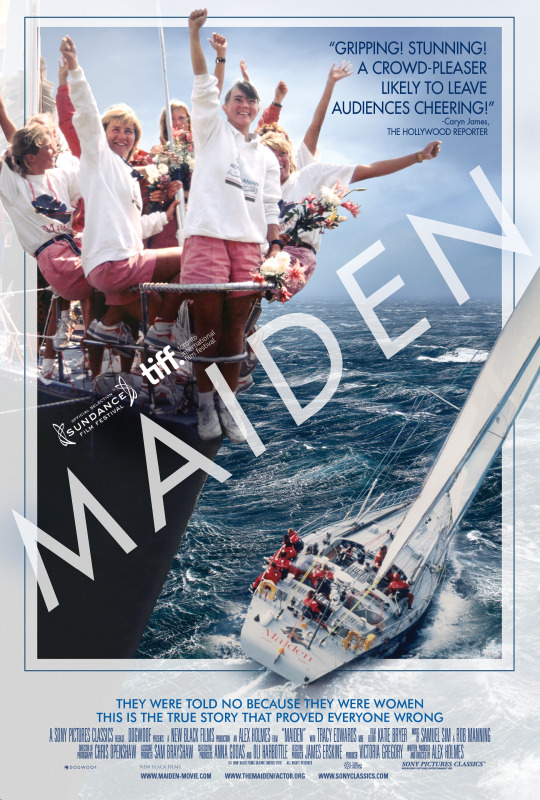
[x]
KY: That was the ‘89 race, and y’know, it really was just, I feel like there has to be some kind of movie about the ‘89 race, not necessarily about Maiden in particular. But just because there were so many different events going on, it almost doesn’t seem real that it was at this point in the world– that the Berlin Wall came down and…
DR: We weren’t even aware that that was happening because we were out at sea. There was satellite navigation really around the middle of the Earth, around Antarctica you were still using celestial. The electronic communications for weather– we would get a weather fax that was on that fax paper, where you get it too hot or wet and you can’t read it. There was a positioning once a day, but our only communication was SSB ham radio, single-sideband. So we weren’t picking up on the news.
KY: I have the “Maxi” book that I saw on the shelf, I got that one at Strand also, and I was looking through that and looking at the computer technology that they had onboard as research for my story. But just this… you came back to port and you would get all of this news that the world was changing so rapidly in this period. Did you have a sense that, y’know, something’s in the atmosphere?
DR: No, no, no, no. We were just isolated. I was literally talking about this last night with a friend’s nephew who just came back from Germany. He hasn’t been in America for three years. And I said, at least you have the Internet, because when I used to come back to do an event or a speech or something, I would at the airport, get People Magazine. Because there was no social media, there was no TV that we were watching. And I came back and there was a social event and people were talking about “Britney”. And I’m like “Who the heck is Britney and what’s her last name?”
KY: Britney Spears.
DR: Because if you’re gone and you’re not hearing it, you have no idea and the whole social world has passed you by. So you have to do some homework to catch up.
KY: In some of the books, they say, you know, the world could end and we wouldn’t know until we got to port.
DR: Uh-huh.
KY: I think in Skip Novak’s book, he said that they were at sea when the Chernobyl accident happened and they had heard that on the radio, and they were like, “What if we come back to the northern hemisphere and everyone’s dead of radiation poisoning?”
DR: Right, right. You are isolated, out there. Or you were isolated out there. Nowadays it’s much different. Nowadays, I think it’s lost a lot of the romance. There’s more people following– you see Cole Brauer and half a million people following, but is that entertainment or adventure? I’m not sure which.
KY: That was the first time you had been to the Southern Ocean, right?
DR: Yes.
KY: What was that experience like, being there for the first time?
DR: (deep exhale) Everybody says they want to be helicoptered in just for a day, which would be a disaster. Because the way that you acclimate to the Southern Ocean is that it’s a little windier, it’s a little windier, it’s a little windier, and each step up, you’re like “Oh my god! Oh, oh, oh!” And then on the way back down, as you’re coming out, you’re walking around in 50 knots of wind with a cup of coffee and you’re not spilling it. So it’s an acclimation, it’s not like you’re helicoptered in, “This is the Southern Ocean!” It’s a gradual in and a gradual out. There are moments you absolutely remember, just the amount of energy and extremeness and the adrenaline of sailing is pretty cool.
KY: From what they say, it sounds like it’s almost a world apart. Otherworldly.
DR: It is, I mean, everybody talks now about Point Nemo, we didn’t even really talk about that then, which is when you’re closer to the space shuttle than you are to land.
KY: Francis Chichester, he said, “I felt like I was planetary distances away from the rest of mankind.”
DR: OK, I wasn’t that eloquent.
KY: But was it like you were on another planet?
DR: We were racing as fast as we could to get to the next piece of land. And that is the thing people always ask, “Are you bored?” No. Because you’re in a competition, it might be a very long competition, but you’re in a competition. And yes there’s some fun times and there’s some relaxing, there’s laughs. But you’re focused. When you’re steering the boat, you’re trying to steer the boat as best as absolutely possible. When you’re trimming, you’re trying to do it as best as absolutely possible. You’re just doing it for a really long time.
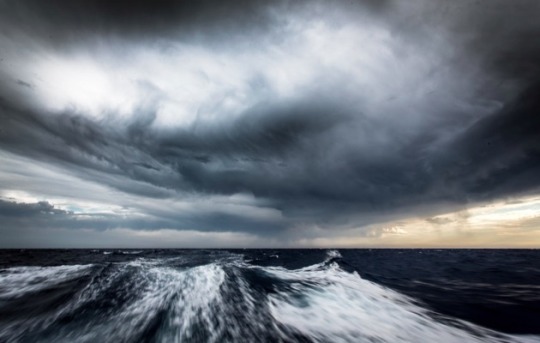
It sounds pretty intense. [x]
KY: And there were several different nationalities onboard Maiden. It was organized in England and it was majority Brits, so how did you feel as an American being among Brits?
DR: Well, it wasn’t majority British, if you count Welsh, and Irish and Scottish, which they absolutely would. There were three proper English onboard. And then, it was weird being the only American only in that it was the first time I had ever been in an experience where I was the only American. I wasn’t even aware of a lot of the stereotypes until they started teasing me about it. “Seppo? What’s Seppo?” It’s like, septic tank. (laughs) But I didn’t know.
KY: It’s the Australian word for Americans, yeah. You know, when I’ve been doing the research for my writing, I type in “Whitbread Race” [in a search engine] and one of the suggestions is “Did Maiden win the Whitbread Race?” Because it’s become so famous now because of the documentary. So how do you feel knowing that you guys are now the most famous team that was there in 1989?
DR: Well, that’s fine. There was also the photo of my cleavage that was the most published photo of all of 1989. Or actually, 1990, because of the finish in Fort Lauderdale. In 1990, the absolutely top-published photo in sports was of my cleavage.
KY: …I’m sorry.
DR: (laughs) Back then, I wasn’t embarrassed, I didn’t even really care about it or know about it, but I was not a fan of coming into Fort Lauderdale as sailboat racers, in our bathing suits, because I thought it cheapened what we were doing. And I was quite against it. Ironically, then that photo came out and now I look at the photos and I’m like “Oh, if only I looked like that now!” (laughs)
KY: Did you have that, you know, almost stereotypical expression after you came back, thinking “I won’t do that again!” or did you immediately say, “I want to do that again next time.”
DR: Neither. I figured, I’ve checked the box, now what am I going to do? I was literally trying to decide between the Olympics and the America’s Cup when we finished. I did not intend to do the next race, I only did it because there had been a mutiny and I had to save the reputation of ‘89-90, because if the women had failed, then it would have been a step backwards further than before Maiden. Because Maiden was about “Can they do it?” “Yes, they can? Oh, that was a one-off.” That would have been the story.
KY: So you did the America’s Cup in 1992, and you were the first woman in a physically-active role [on an America's Cup crew in 140 years].
DR: Mmm-hmm.
KY: How did you end up joining that team?
DR: Open try-outs. There was a handful of women that tried out. I was just the only one that made the team.
KY: This is also, significantly, this is also the year in which there is the movie made about the America’s Cup, Wind, that’s the fictionalization of the events of 1983.
DR: That’s right, that’s right.
KY: And that’s kind of an alternate universe sort of story, but it struck me that this film that was set ten years before did have female crew, something that only became a reality that same year.
DR: I didn’t even think about that. I was so busy just training to go racing.
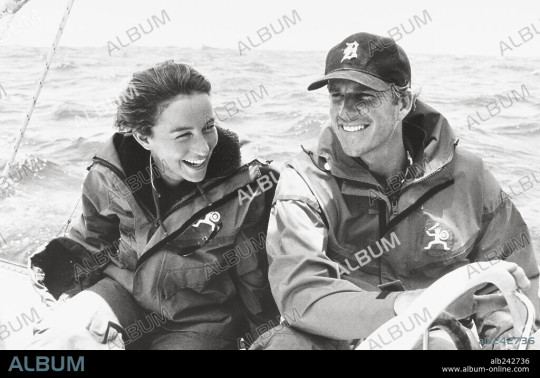
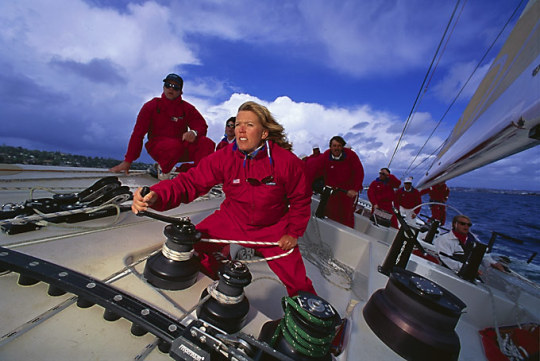
Left: Fiction, Right: Reality
KY: Were you aware of the movie when it came out?
DR: Oh, of course. We were aware of the movie. And I think I remember thinking it was okay. Everybody teased, everybody was joking about it. But I think it was pretty successful, pretty well-done. I had actually been asked to be in the film as a stunt-double at one point, and I thought they were joking. It turns out that they were, but it doesn’t matter– I was busy.
KY: Yeah, it’s one of those love-it-or-hate-it movies, y’know? I love it, I know people who hate it, but I love it.
DR: I don’t hate it at all. I’ve watched it a few times. There was a movie called Masquerade that I liked better, and it didn’t get nearly as much press.
KY: I like to joke with my friends that I’m one of the 600 people on Earth who have actually seen Wind.
DR: Oh no, I think there’s a lot of people that have seen Wind. Every junior sailing kid who has been at a program when there’s no wind out, gets to see Wind.
KY: You were part of America^3–
DR: America Cubed.
KY: Yes, America Cubed. Did you have the sense that you were the first?
DR: Oh yes. They maximized it in terms of publicity. We had three of us, there were two black guys on the team. So Art, myself, and Billy Ruh would go. It was the girl, the cute white guy, and the star black guy, we’d call ourselves the Mod Squad.
KY: Oh, like the show, yes.
DR: Which was a TV show from the 60s.

The America^3 crew were nicknamed "The Cubens" (pronounced like "Cubans") [x]
KY: So then you were in the Whitbread in 1993 again, like in the book. You joined the team after Leg 1 because there had been the mutiny and so forth… I almost don’t even want to ask anything because you said it all so well in the book!
DR: (laughs) So then just tell everyone to read the book. You can buy it now [online], it’s in paperback because we sold the 50,000 copies in hardback.
KY: In the book, there’s the contrast between the management side of the team and so forth and dealing with the lawsuits and the money troubles, whereas you said when you’re out at sea, you’re focused on very specific tasks. So did you actually prefer the simplicity of focusing on what was going on aboard ship.
DR: It’s ironic. Because when you’re out there, all you really… it’s actually pure. It’s wonderful. It’s amazing, because you’re just focus, focus, focus. And you’re just trying quickly to get to shore. And with the second attempted mutiny on the boat while we were racing kind of took that purity away, so it wasn’t as good as with Maiden. The second time around the world or the second time you’re in the America’s Cup is never as pure and fun with that sense of discovery as the first time. The ironic part is that you’re racing and all you want to do is get to shore and see people and have a glass of wine and have actual vegetables that aren’t freeze-dried. And then you get there and somebody hands you a beer and then you forget about all of that. The first couple of days onshore are really annoying because there’s so much distraction and then you get into a routine and then before you go back, you are like “Ohhhhhh, I don’t want to go to sea, I want to stay in bed.”
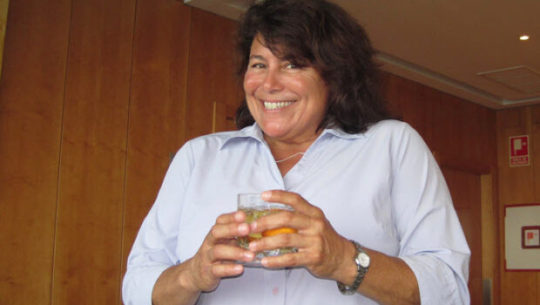
[x]
KY: You captured that so well, talking about being in South America and hearing the winds keeping you up at night. And in the book you wrote a lot about Gloria Borrego, who recently passed.
DR: (quietly) I know.
KY: She sounded incredible. Could you talk about her?
DR: She was incredible. She worked in the pits in NASCAR, she was a brilliant engineer, a problem-solver, always laughing. Amazing. Diana Klybert wrote her obituary, which summed up more than any of us knew in terms of one aspect of her, and it was tragic that she got cancer and died within two weeks. One of my other friends, mutual friends, was upset and said that she had so much left to do. But I pointed out, she had done so much.
KY: Just the good humor that came through in the book, where you were joking among yourselves, she was talking about her dreams, and she talked about how she dreamed she was a superhero. That was incredible, just so fun to read.
DR: Yup.
KY: And you also talked about how you were getting letters from students and that you were impressed that people were following you.
DR: Yes, because you wouldn’t remember, you weren’t alive. [Actually, I was seven months old when the 1993 Whitbread started, but close enough.] But the Internet was just starting to happen and CompuServe was the e-mail. So we would sent a fax to a supporter in… Annapolis, I think? And then he would e-mail it out, because you couldn’t take a picture then, you couldn’t send attachments, he would re-type it into an e-mail and send it out to people via fax or e-mail. It was basically an early version of a listserv.
KY: Yeah. I think that really the Whitbread and the America’s Cup were kind of pioneers in using the Internet for education [and outreach] and that way of letting people follow. The Whitbread website from 1997 had almost all of the modern features and everything! I know that in the 1995 America’s Cup, there was the PACT organization that was doing newspaper things for students every week. Really impressive stuff.
DR: Sailors are early adopters. Because we are so remote.
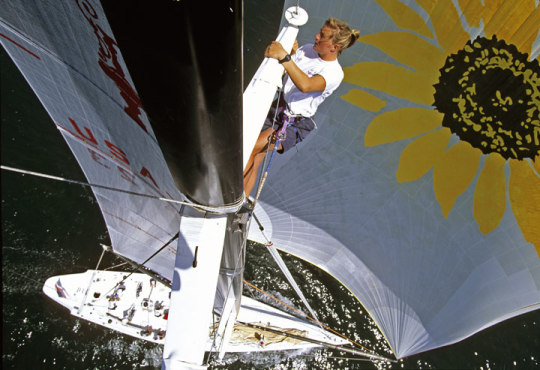
America^3 in 1995. [x]
KY: 1995, you were with the other America^3. Where it was specifically a women’s team. So that was, I suppose, the next step, now that there had been female crew, that there had been–
DR: 1995, yeah. It was basically because Bill Koch and his financial advisors didn’t want him to spend all of this time and money and effort to do it again and underwrite it.
KY: He had to do something different.
DR: And so they came up with the idea of, should we do an all-women’s team. They asked me, and I said, “Noooo, let’s just sail mixed, it’s more fun.” And then I sat down and helped write the business plan for that, we called it the Manifesto, but it was a business plan.
KY: I just thought when I read Huntington’s book and it was talking about the team dynamics and so forth and who’s in charge and interesting like that, talking with the trainers and so on. And here’s now we do certain things. I thought it was very funny, the story about forcing one of the chase boat guys to listen to you [all] talking about menstrual problems because he had been annoying or something.
DR: I don’t remember, there was a lot of funny stuff like that. Now, Anna was a rower, she came in kind of late on the team, but her background was journalism, so she wrote a journalistic story, which I fully support. It was slightly sensationalized to be able to sell books, a lot of the other women were very upset because it told too much. My belief is, whatever you do, you should be proud of it. So if everybody knows, it’s on the front page of The New York Times, then tough. You did it, you said it, it’s there, it’s true, share it.
KY: I thought especially talking about the resistance that she faced, I was very impressed by that, it was very scathing in certain places. Talking about specifically the things that people said when they doubted you. I was joking with my friend, I said “She called this book Making Waves because the publisher probably said ‘You can’t call it Screw You, Dennis Conner!’” (laughs)
DR: Okay, yeah. We don’t like Dennis, but he’s now old, he’s older. He’s, yeah…
KY: He disappeared.
DR: Yeah.
KY: And obviously that’s another incredible year in the history, with so many things going on, you literally saw a boat sink in the racing–
DR: Yeah.
KY: –and the different nationalities involved, of course it’s the year that Team New Zealand are just sweeping through. So, again, did you have this sense of being impressed that so many crazy things are going on and you’re in the midst of it?
DR: You’re in the midst of it and you’re trying to just get stuff done. It was a different campaign. It was extremely unfortunate that we had no women in the leadership onshore, obviously we were on the boat, but you need to have that crossover and it was just math, to a point. Because if there had been more women that had had experience in the past, then we would have had more women on the coaching staff, more women on the design team, more women in the marketing team. So you would have had more of a cohesive team, as opposed to the guys do this half, all the business, and the women just hurry up and go sailing. Which hurt us a little bit in some of the decision making.
KY: Yes, I got that sense from the book. And then you did have a mixed team in 2000, with America True.
DR: And we hired the designer of the boat that sank. (laughs) Because he was definitely not going to build a boat that was going to sink.
KY: (laughs) I’ve actually read the official program for that edition, I got it online, and I have a question I’ve gotta ask…
DR: Hopefully I know the answer.
KY: Why was Godzilla on America True’s hull?!?
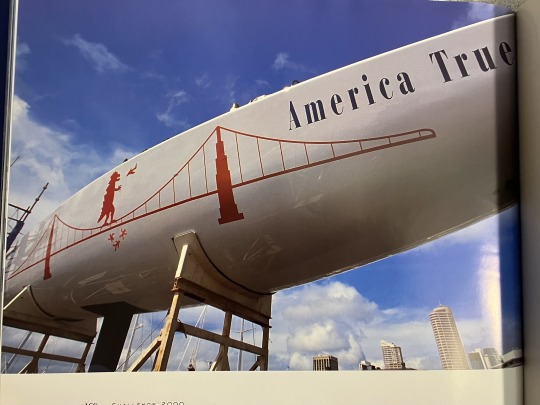
Reproduced from Challenge 2000: The Race to Win the America's Cup, by Russell Coutts and Paul Larsen.
DR: That’s because… it’s hilarious. So, in the America’s Cup, there’s extreme security, you’re not allowed to go into another team’s base, you’re not allowed to take photos because of certain parameters and all sorts of stuff. And we did have some espionage, but that was, I’m pretty sure I know who– I’m pretty sure it was a Kiwi– and when we came in in the morning, it was so hilarious. So they’d snuck in and they’d put Godzilla on the Golden Gate Bridge that was on the side of the hull. So it was just a prank. We could have protested them and had “damages” because they were in the base.
KY: They touched the hull.
DR: Some of the people were upset about that, and myself and Chris Coffin just thought it was so f—-ing funny. We were like, “Leave it!” So we left it on forever.
KY: In the photos in the program, it’s there and I thought that you guys did that.
DR: Nope.
KY: But I thought, I’ve gotta ask why. In this case, you were in Auckland and y’know, this is not necessarily the period where it became– because it already was– that it was so integrated into the culture there. Did you have a sense of that, that this is a place where so much of the country is watching this?
DR: Oh yeah. Because I’d lived in New Zealand off and on since 1992. It was my home. I was actually in London a week ago and staying with Jenni and Spike– Jenni was on both Maiden and Heineken and Spike was on New Zealand Challenge– and I said, I think there’s more friends per square mile of mine in New Zealand than anywhere else in the world. Just because I know so many of them and they’re good friends. And I was lucky to be sailing internationally when it was the decades of the Kiwis, and they’ve all gone home to roost.
KY: And you said in Taking the Helm, when you guys got into Fort Lauderdale, you told the people who were not Americans, you said, this is the United States, there’s not going to be as many people as there were in New Zealand because we don’t turn out as much, so…
DR: Well, no, it’s because they didn’t know that the race was happening as much.
KY: Did you have a sense that this was so much a part of the culture, that people are going to recognize you on the street?
DR: They do. They still do.
KY: It’s a very different sort of experience, the way it’s integrated into their culture?
DR: Yeah.
KY: Like you said, Peter Blake was a national hero.
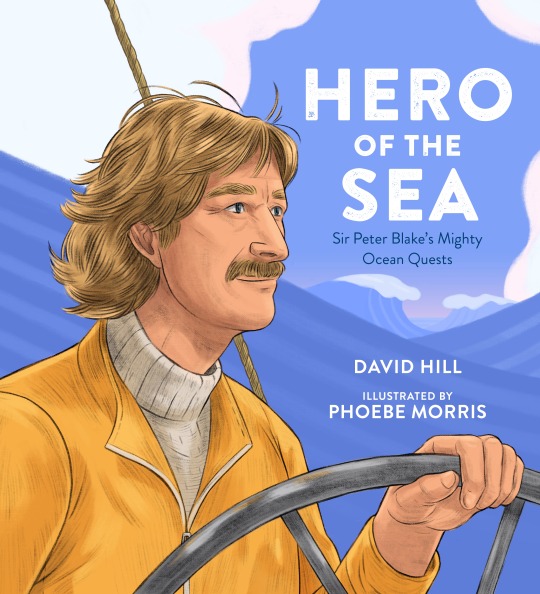
There are even children's books about him! [x]
DR: Well, there’s a big difference. New Zealand has a huge coastline, somewhere around 90% of people go boating regularly, it’s something insane like 86% own a boat, whether it’s a rowboat, or a launch, which is their word for a powerboat, or a yacht, which is their word for a sailboat. So of course you’re going to have more following. As opposed to, how many people in Kansas, Oklahoma, Idaho, North Dakota, South Dakota, y’know, Texas… there’s coastlines somewhere in there, but there’s so much vast, non-coastline.
KY: So would you say that our cultural disadvantage is our geography, in that way?
DR: It’s just different. Just different, yeah.
KY: So then, you were in management and media in the next two editions. Flip those around, media and then management…
DR: I was doing media coverage in 2003 and then I did sail on the boat up until the last 8 months, and I was general manager of the French team for 2007 where we raced in Valencia.
KY: That was K-Challenge. And this is, talking about, three different countries within a decade, that the America’s Cup was in. And with the people who are part of that, involved with that, they talk about their kids going to school in different countries and so forth. So what’s it like, just that nomadic life? Where you know that now we’re here, but we don’t know where we’re going to be in five years because we don’t know who’s going to win? And just going somewhere else, do I have to learn a language, learn basic phrases and so forth?
DR: Well, I mean, that’s a privilege, to be able to go and live in all different countries. Until Oakcliff, I had not lived in any place more than three years after I was 11.
KY: That’s amazing.
DR: It’s cool. And you keep light, you don’t collect a lot of c-—, and you don’t need a lot of stuff. You collect experiences and friends, as opposed to material things.
KY: And I know that in your book and also in Making Waves, you talked about, or people talked about you, reading home and garden magazines because it was something that was different from your own life.
DR: Well, yeah, also if you’re moving to a new place you want to– nowadays we call it nesting– but you want to take the time and that’s you’re creative outlet, to make things pretty. To do gardens. I think somewhere it’s probably written that if I garden, I want something out of it. So I specifically garden with vegetables and some fruits. Flowers are there… marigolds to keep the pests away, but it’s not to make it pretty. It’s to make it productive.
KY: Practical gardening.
DR: Yup.
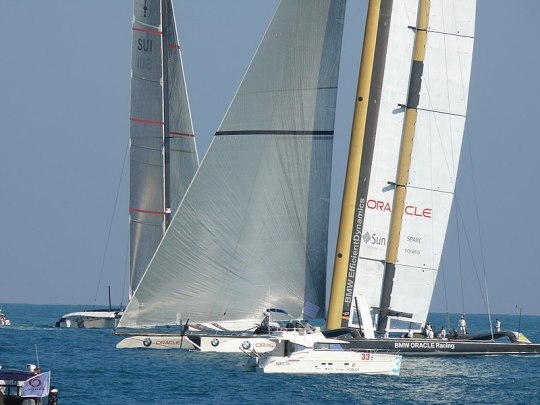
14 years ago, the beginning of the AC multihull era. [x]
KY: Since that point, y’know, we’ve seen the America’s Cup change so much with technology and so forth. And that was sort of the point you moved out of that, you were working at Oakcliff, but how has it been watching all of these changes in the past fifteen years?
DR: (clicks tongue) Yeah, it has been fifteen years. I’m obviously out of the inside scoop on technology, I think the challenge is that there has been a concerted effort to make it marketable to the masses. And when I did the television in 2003, I learned, believed, and reinforced my belief that the way to make it entertaining and relevant to the masses is to educate the masses. Because sports fans, even if they don’t do the sport, want to be seen as the experts, so they can talk about it at the pub with their friends and have an opinion. You need to give them the information so that they can form an opinion in the end. That may or may not be right, because it’s all judgemental, but at least they have the tools. Just making something go fast and not educating people is not the answer. So the catamarans and the foiling gecko boats right now are a challenge on top of the fact that you don’t see the humans. People associate with humans. So I think there’s a lot of people that are in agreement with that, the question is, whoever wins, will they have the cojones to make that correct change.
KY: I’ve seen discussions of this, how much jargon do you use and for what audiences?
DR: Jargon is not a big deal. You say port, left side of the boat, starboard right side of the boat. It’s super frickin’ simple and it doesn’t have to be… it’s not the language that’s the problem. It’s the strategy, the tactics, the humans, why are they doing that? Oh, the wife just had a baby or that person’s mother just ended up visiting in town, the paint is a new coating that they think is faster, is it going to be faster or is more of a psychological advantage? Those kinds of conversations pull people in. And in all of that, I didn’t use a single sailing term.
KY: Right. The thing I was thinking, when I was reading the book on the beach, and it was 2020, I was in lockdown, and I was waiting for the next edition coming up in 2021. And it was at that point that DutchSail had pulled out. And I was thinking, you know, this is 25 years ago, and there was this cohort of women who were crewing, and now they’re not. I felt that this is the light that failed. How did you feel that there has been a technological revolution in the America’s Cup but not necessarily a social one?
DR: Well, there has been. Not in the America’s Cup, but SailGP, the Round-The-World, they’ve gone back and forth between incentives and requirements, and it’s making a difference. The America’s Cup is not going to put those rules in because almost all the rules are some sort of mutual consent, so you have to have at least two parties that are wanting to win to the death. So the only way that you’re going to be able to have women in the America’s Cup, I predict, by regulatory, by rules, is by having a sponsor who says we will give you corporate dollars as long as you have x number of women on the boat. Or you have the challenger and the defender who both believe it’s a competitive advantage for them to have their female on the boat. And then if they both believe that, then you’ll end up with women on the boat. But it’s really hard.
KY: Do you think that if you had been in the match in ‘95, that it would have been different?
DR: No.
KY: That people would have said, see, clearly women can be at least in the match, so…
DR: No. I don’t think anyone makes that distinction. That has nothing to do with it. And also, frankly, the Kiwis were so much faster, that we would have been seen as the women that lost the America’s Cup. So, no.
KY: And then with the set-up they have now, where they made a separate event.
DR: That’s… silly.
KY: Yes! That’s what I was saying, that I feel like previously it was by rule, open, but de facto all-male, now it seems like it’s de jure all-male, because you’re separating.
DR: Where it does help, and where it may help the overall event in the future, is because they’re focusing on women and youth, countries like Holland, Australia, I don’t know the other…
KY: Canada?
DR: Canada, those countries have an entree for young people with a longer runway, launchpad, to get into whatever the next America’s Cup is. So from a marketing perspective, it’s extremely good. Do I wish that we just had women on the real boats? Absolutely. And in particular, in the US, there’s at least two women that are relegated to the women’s team that absolutely should be on the real team.
KY: I feel like when you say “The Women’s America’s Cup”, that’s different from saying “Women IN the America’s Cup”.
DR: Correct.
KY: And with what you were saying, having a women’s team vs a mixed team. That when it’s a women’s team, there’s focus on that, whereas if it’s a co-ed team then it’s just people.
DR: Just people, exactly. We need to sail with people.
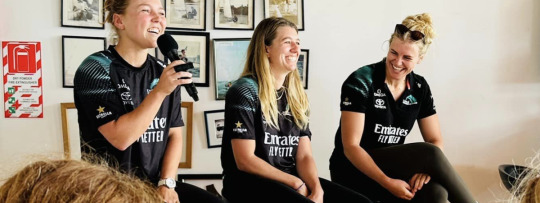
Liv Mackay, Gemma Jones, and Veerle ten Have of the New Zealand Women's America's Cup Team. [x]
KY: Now you work at Oakcliff and you have for 15 years now…
DR: 14.
KY: 14.
DR: It’s only 14. (laughs)
KY: What are some of your duties and responsibilities here?
DR: I’m the executive director and that means doing everything that needs to get done, from making sure that Matt’s buying the right washing machine ‘cause the kids don’t all take c--– out of their pockets and it ends up in the pumps and breaks them– that’s an eight-hundred-dollar mistake– to getting the art show set up, to the fundraising, to coaching the development person about marketing, to cleaning out the shop, to supervising the composites– although Luke’s doing an amazing job there– to sailing, to coaching.
KY: What is this art exhibit?
DR: It’s a fundraiser. So, we have an art show April 6th. We have one every spring. Hunt Lawrence is our main benefactor, and his wife is an artist and she has an art school in New York– New York School of the Arts– so we do a joint fundraiser every spring. And then she does a fundraiser in the fall with art shows. So it’s an art exhibit, there’s a champagne brunch, and all the art’s for sale and a portion, minimum 20% up to 100%, goes to Oakcliff. Hunt doesn’t care as much about all of that, he just thinks it’s really cool that we have a deadline to clean up the place from the winter mess to the summer.
KY: (laughs) Oh my god.
DR: (laughs)
KY: So what is life like for the students here?
DR: You can and should ask them. It depends on the season and the day. I’ve seen more people come through here, we’re at nearly 600 graduates, or over 600 graduates. And some years, it’s kind of the wild west in the beginning, where they’re living offsite and nobody under 18 was allowed. Sometimes we have super-young groups, just because we’re 15 and above. We had one camp where it was 8 boys and girls between 15 and 17, and then 3 women that were in their 60s. And it all worked, but it was awkward in the beginning and it became a great team-building event. At the very end of that particular camp, we had a competition where they divided up into teams and they would do a cooking competition where they could only use stuff that was upstairs, kind of like on Top Chef. They all brought it to my house for lunch and we awarded, I think it was a watermelon soup with a basil-olive oil puree drizzle and a sprinkle of feta that won.
KY: That sounds great.
DR: It was great. It was a 15-year-old boy that made that.
KY: Are you satisfied with what you’ve achieved at Oakcliff?
DR: We’ve achieved amazing things. Our goal right now is to make it sustainable without me onsite and without our main benefactor. So that’s our next frontier. At the same time, we’re under pressure to expand into Florida and to California, which is totally doable but I need to clone myself a couple times.
KY: Now that you’ve had so many people come through, what are some of the things you’ve seen your students achieve?
DR: I go back to Seth Cooley, is one of the top engineers at Future Fibers. Ervin Grove was running the North Sails loft in Charleston. Madeline Baldridge now is married to a coach who was here– and he is a son of our navigator from ‘92, so it’s a small world– she is one of the designers for North Sails. Chris Kennedy works for Melges and he and his wife have a flower farm in Wisconsin. Mark [Towill] and Charlie [Enright] obviously won The Ocean Race. Five of our graduates are working with American Magic. Robyn Lush is working with them a little bit, she’s also become an ultra-marathoner. Koko [Komar] is working in commercial real estate. Mike Nicoletti has a hedge fund. And that’s just off the top of my head.
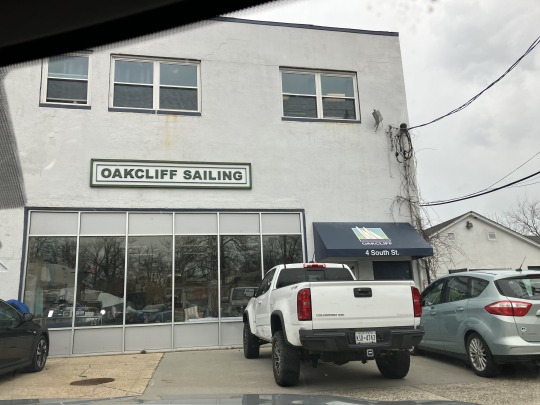
X-Men comics and Percy Jackson novels taught me that all good specialized schools for young people with extraordinary talents must be tucked away in small towns just a train ride away from New York City…
KY: Do you feel like you’re almost, I guess, Professor X, finding the young talent and helping them…
DR: Of course. Of course. We’re giving them the opportunity to come in and try things out. It’s not always an easy thing. And it’s a little bit like I suspect parenthood would be. You’re just like, this kid is driving me frickin’ crazy and they hate me right now, and then 5 years later I’ll get an e-mail from them saying, “I was a jerk, and you were mean to me, but I needed it, thank you.” I just wish I didn’t have to do that over and over and over again. But we try to just keep it at a professional level, acknowledge that we’re asking for ultimate effort, and that not everybody’s going to succeed, but you know where the bar is.
KY: You talked about having the other locations. What are some other things you’re hoping for, for the future of Oakcliff?
DR: Again, the sustainability so that I don’t have to be here. Because it is a model where we have tuition for the Saplings, we have sponsorships, we have art shows. We have income lines, retail, and yet we need to fund-raise for the overhead, essentially. So about 50% of the budget comes from charitable donations. One thing that would make it more sustainable is to be able to get the landlords to agree to sell us the property, because then we would end up net positive on the bottom line. We do a capital campaign so we don’t have to pay rent. We’ve worked on getting the insurance down. So there’s a lot on the business side of it. It’s really boring to people, but we use our dollars. Around 90, I think the lowest we’ve been is 87% of every dollar goes to programming, and we’ve been as high as 96%. So we’re the golden children of utilizing every dollar for programming.
KY: Would you say that your reputation and star power are important to–
DR: My reputation, I’m not going to say star power, but my reputation and credibility is what built Oakcliff. The good news is that 5 years ago, 8 years ago, everything that happened at Oakcliff would reflect on me. Now Oakcliff’s grown to the point that if I just slowly took a backseat, it’s its own entity, which is a sign of success. Because it can’t be attached. If I get run over by a bus, 8 years ago, everybody would say, well, Oakcliff’s done. Same thing with our main benefactor. Now we’re trying to get it to the point that it’s not surrounding just one person. It’s more of the reputation of quality and a community.
KY: And I think we can see that it has to be larger than just the person.
DR: Absolutely.
KY: That the leader is not the whole organization, and if the organization is seen as too closely tied to the leader, then anything the leader does reflects on the organization and that can be a weakness.
DR: Exactly.
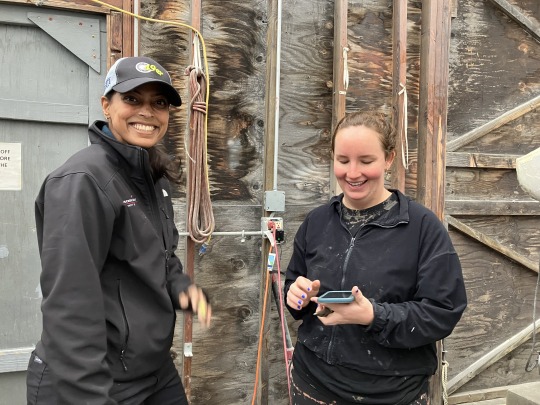
Oakcliff trainees Sweta Shervegar and Noelle Scheer in the boatyard.
KY: We spoke about the role of the sport of sailing in American culture. There has been, I would say, especially with offshore, sort of a decline in visibility in the past 25 years and so forth. And everyone’s got their own reason for that, y’know–
DR: Well, part of it is that it’s become more accessible. Before, there used to be one race, and only a handful of crazy people dared to do it. Now it’s become safer, more communication, more safety equipment, more rescue opportunities, more people. Again, Cole Brauer, in Class 40, livestreaming dinner parties… I mean, I didn’t take a shower for 5 weeks, and I barely had time to write in my diary and drink Ovaltine. Y’know, so, it’s a different… it’s more accessible, so it seems to be easy, but it’s also become more fractured.
KY: There’s many different races attracting attention, but also attention in general is more split because of the Internet and more TV channels. But it seems like, also, I feel like now “sports” means “ball sports” more than it used to.
DR: Say that again?
KY: I feel like now, when I look at ESPN and so forth, “sports” is ball sports more than it necessarily was when you guys were getting your specials on ESPN and so on.
DR: No. When we were back in the day, to have anything on other than football, basketball and baseball in America… even hockey struggled. It’s changed. There’s so much more inventory again, technology allows you to produce high quality broadcast-ready programming, so women’s sports has benefited hugely from that.
KY: Yes.
DR: Sailing is on TV more than you would think, but there’s also more clutter.
KY: I remember when the documentary came out, people said, if Mike Plant had lived, then we would have had an American visibly in the Vendée [Globe] and that would have brought more visibility for offshore [racing] in the United States. And now we do have some American offshore figures with 11th Hour Racing and now with Cole Brauer who are getting all of this attention. Do you think that’s a positive development that we have these people who are…
DR: Yeah. Of course it’s positive. The thing is, how do you channel it for a purpose and what is that purpose? Is it more eyeballs for your sponsors? That’s one thing. Is it more people in sailing? That’s a different thing. Is it a more robust industry? That’s another thing. Is it more environmental and ecology awareness? That’s another thing. Just taking this power, which seems to be scattershot, and putting it into a clear mission and achieving that mission. And all missions are achievable, you just have to know what it is that you’re trying to do. I think Cole is a perfect example. She didn’t expect it. So now it’s going to be really interesting, I think she might be going over to MerConcept. She has power right now, I know she has advisors, and her advisors and she have to make a decision. She could do like Ellen MacArthur. Ellen doesn’t sail at all, but she has her Ellen MacArthur Trust and she uses that to do specific charitable work. I think Cole’s probably too energetic, dynamic to stop there. But what does she want to do?
KY: What do you think that she did well, particularly with the presentation?
DR: The amount of followers she has is crazy. And she has brought in a huge non-sailing audience. And there is a legitimate discussion, like I talked about way back, amongst technical sailors, about the merits and how this happened. And again, she needs to decide what her purpose is and how she’s going to capitalize on something that she’s built that’s amazing.
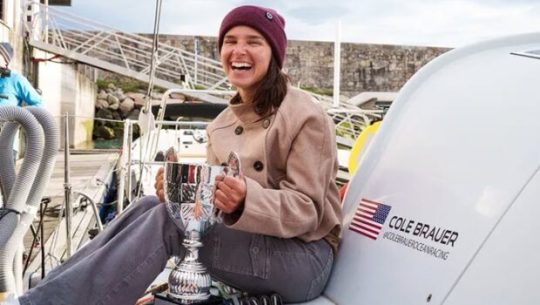
[x]
KY: You were talking about also, the 11th Hour people who came through here. What would you say that they have perhaps done well in presentation?
DR: 11th Hour changed the conversation around the environment hugely and now they’re moving on to women with the MerConcept, which is François Gabart. And that’s Wendy Schmidt, that’s from the top, that’s a female decision-maker and leader.
KY: I wanted to say this before, but talking about the management side as well, you said that there has been a social revolution in the past few decades. I actually saw the interview for the 25th anniversary of America^3, where they had Melanie Roberts who’s the race coordinator for America’s Cup and for SailGP. And that she had been, I think, ten years old watching you guys? [Roberts was actually 9 at the time of the 1995 Cup.]
DR: Oh yes. Yes.
KY: The people on the boats get the most attention, but there are people at all levels who are sort of this generation that has been inspired by the people before them.
DR: Uh-huh. This sport is… it’s complicated. It’s an industry, and a sport, and a lifestyle, and a pastime. It’s all in one. We’re not going to talk about, we don’t need to talk about the Olympics, but that’s part of the national governing body of US Sailing, they also need to figure out what they can do and once they figure that out, they need to do it well. And they’re doing none of it well at this point. Because it’s so complicated. Unlike skiing, perfect example, there’s the Olympic ski team and then there’s the recreational part of it, so all the ski hills have a business association that then spins off some funding for the Olympic team.
KY: Are there any other people you think who are impressive competing nowadays, who came through Oakcliff or otherwise, who you think I should be following?
DR: I started going through names there, Lena Kurbiel is rowing with Liz Wardley [across the Pacific], so there’s one. Sydney Monahan has finished school, she’s going to do a Women’s Match Racing campaign. Sweta, our high-performance coach, is going to go over to MerConcept, Michaela [Robinson] is going to be over there trying out. If I started looking down the 600 people, I would have 600 names for you to follow.
#dawn riley#oakcliff sailing center#interview#female sailors#Whitbread Round the World Race#Whitbread 1989#Whitbread 1993#America’s Cup#AC 28#AC 29#AC 30
10 notes
·
View notes
Text
You know, I hope George Bailey kept renewing his National Geographic membership from when he was a kid so that even as events kept preventing him from leaving Bedford Falls and going to see the world like he wanted, he could at least keep reading and dreaming about being an explorer, and probably sharing the maps and pictures with his kids once they were born. (And certainly there were some really incredible expeditions being covered in the 1920s-40s period of the movie— Tutankhamen’s tomb, Byrd in the Antarctic, Beebe and Barton’s bathysphere, Auguste Piccard...)
9 notes
·
View notes
Text
Sub-mission
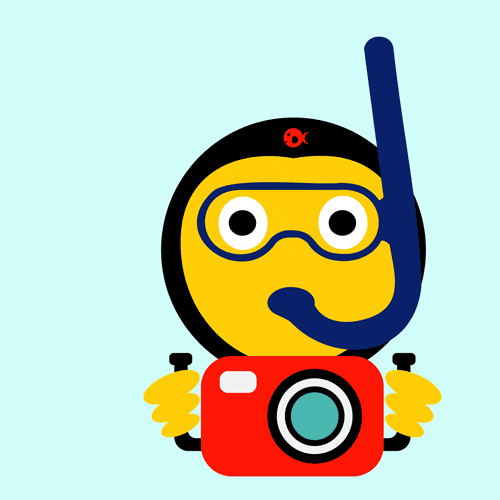
A vessel with the ability to operate independently underwater is known as a submarine (or sub). It contrasts from a submersible, which has less capabilities for diving underwater. In the past and now, it has also been used to describe small or medium-sized ships like the midget submarine and the wet sub as well as remotely controlled vehicles and robotics. Regardless of size, submarines are referred to as "boats" rather than "ships."
They range from modest autonomous examples, one- or two-person subs that operate for a few hours, to vessels that can remain down for six months. More depths than are practical or safe for human divers can be reached by submarines. There are certain civilian submarines that are used for tourism, exploration, oil and gas platform inspections, and pipeline surveys, despite the fact that most submarines in the world are military vessels. Some of them are also employed illicitly.
The Submarine Voyage ride opened at Disneyland in 1959, but although it ran under water it was not a true submarine, as it ran on tracks and was open to the atmosphere. The first tourist submarine was the Auguste Piccard, which went into service in 1964 at Expo64. By 1997 there were 45 tourist submarines operating around the world. Submarines with a crush depth in the range of 400–500 feet (120–150 m) are operated in several areas worldwide, typically with bottom depths around 100 to 120 feet (30 to 37 m), with a carrying capacity of 50 to 100 passengers.
In a typical operation a surface vessel carries passengers to an offshore operating area and loads them into the submarine. The submarine then visits underwater points of interest such as natural or artificial reef structures. To surface safely without danger of collision the location of the submarine is marked with an air release and movement to the surface is coordinated by an observer in a support craft.
Case in hand:
Your company is planning to launch India’s first ever glass submarine that can go as far 80 feet deep into the ocean and gives its passengers a unique experience of interacting and observing marine life.
Task in hand:
You are the CHRO of India’s first tourism submarine company. You have to come up with the following:
Name of the Company
Mission, Vision and Objectives
List the different job roles offered
Strategies to recruit your employees
Describe the different activities and facilities provided in the tour
A detailed itinerary encompassing the tour.
Deliverables:
A ppt presentation of not more than 9 slides
Submission Details:
Deadline: 8:00 AM Tomorrow (21-09-2022)
Email: [email protected]
Email Subject and File Name: Submission_ECOXX
P.S. The deeper you dig, the better
2 notes
·
View notes
Photo



National Submarine Day
Pay tribute to the many souls lost beneath the ocean, and consider the game-changing effects of the invention of the Submarine on our technology, warfare, and more.How low… can you go? How low… can you go? When it comes to National Submarine Day, it’s easy to believe that it’s pretty low.
History of National Submarine Day
Some people may find it hard to believe that the first recorded submersible was built by Cornelius Drebbel in 1620! This underwater ship was apparently built for James I of England for use in London, although why anyone would want to plunge beneath the surface of a 17th century Thames is difficult to understand!
The original versions of submarines were built to hold only one or two passengers, but modern versions are made to hold up to 100 passengers. Typically, since this is a very dangerous job, militaries will use as few people on their crew as possible.
April 11, 1900 is the date when the United States government purchased its first commissioned submarine, named the USS Holland. The USS Holland was the United States Navy’s first commissioned submarine, named for her Irish-American inventor, John Philip Holland. (It is important to note that this was not actually the first submarine of the US Navy, which was the 1862 Alligator.) But this boat was originally laid down as Holland VI, and launched on 17 May 1897.
Having played major parts in military operations for over a century, today’s submarines are, of course, far more sophisticated than that particular oar-powered contraption. The amount of expertise that goes into their design, construction, maintenance and operation is quite staggering, especially when you take into account the inclusion of navigation and communication networks, sensors, armaments and weaponry, and powerful propulsion systems. This is all in addition to the most important part of a submarine: a large number of rigorously trained and highly skilled men and women who are often putting their lives on the line for their countries!
In honor of that first commissioning of the USS Holland in 1900, National Submarine Day was established to be celebrated each year on the anniversary of this date!
How to Celebrate National Submarine Day
Today’s observance of National Submarine Day can take on many forms. Here are some ideas for making plans, but feel free to go far beyond and get creative with some of your own ideas too!
Visit a Submarine
Those who are serious about observing National Submarine Day might want to consider taking a road trip to a museum or other exhibit where a submarine is accessible to the public. Smaller retired subs often find themselves put on display for adults and children to see and experience what it is really like, in places like children’s museums and science exhibits.
Various submarine tours can be found in port cities in the United States and other countries, including Australia, Canada, the United Kingdom, Denmark, and many other European countries.
Learn Fun Facts About Submarines
In celebration of National Submarine Day, raise awareness for the day by learning about and sharing some of these interesting bits of trivia:
Submarines were used in the American Civil War. The South built small steam-powered subs called “Davids” to fire torpedoes at the ships from the North.
The furthest dive completed by a submarine was 35,858 feet.
The world’s first submarine for the military was designed in the US and built in 1776, the same year the US gained its independence.
The periscope, which is a vital tool for submarines, was invented in 1854 by a Frenchman.
Check Out the Submarine Force Library & Museum
In the US, the only submarine museum in the country that is run by the US Navy is located in the New England state of Connecticut. At the Submarine Force Library & Museum, the first nuclear powered submarine, the USS Nautilus, resides right outside the back doors of the building. Free tours of the sub are given for individuals, families, school trips and more. Scavenger hunts are also a fun way for folks to participate, especially in celebration of National Submarine Day!
Take a Moment to Consider Submarines
In celebration of National Submarine Day, perhaps it would be important to simply take some time to think about and consider this special feat of engineering. Take a moment to think about the ingenuity and majesty of the mighty submarine itself. Celebrate its place in the modern world. Or imagine what these submarines might be like in a hundred years’ time!
But perhaps most importantly, this would be an important time to take a moment to think about those whose lives have been lost at sea over the years and pay tribute to the courage of those who made a sacrifice, whether in the name of their countries or for increased knowledge and science.
Source
#Mesocaph#August Piccard#Verkehrshaus der Schweiz#Swiss Museum of Transport#Luzern#Lucerne#Switzerland#tourist attraction#landmark#technology#engineering#Copenhagen#København#Denmark#Atlantic Ocean#National Submarine Day#NationalSubmarineDay#11 April#travel#vacation#Europe#summer 2006
2 notes
·
View notes
Text
Tal día como hoy 21 de marzo ...
2022: El vuelo 5735 de la compañía China Eastern Airlines se estrella en las montañas de Guangxi (China). Fallecen los 123 pasajeros y 9 tripulantes que iban a bordo. Según las primeras investigaciones realizadas, las causas pudieron ser que un piloto o alguien del pasaje forzó que el aparato se precipitara.

2005: Entra en funcionamiento en Hong Kong la página de descargas Megaupload.
1999: Se completa la primera vuelta a la Tierra en globo aerostático, por el suizo Bertrand Piccard (nieto de Auguste Piccard, inventor del batiscafo) y el británico Brian Jones. El vuelo se inició en Château D’Oex (Suiza) el 1 de marzo, y finalizó en el oasis de Bawiti (en el desierto egipcio).

1966: La ONU proclama de manera oficial el 'Día Internacional de la Eliminación de la Discriminación Racial', con motivo de la Masacre de Sharpeville, ocurrida en esta misma fecha del año 1960.
1963: Se cierra oficialmente la prisión de la isla de Alcatraz, en Estados Unidos, a causa de los vertidos y consiguiente contaminación que producía en la bahía de San Francisco.

1960: Sucede la Masacre de Sharpeville (Sudáfrica), en la que la policía dispara contra una manifestación pacifista, causando la muerte a 69 personas de raza negra e hiriendo a otras 180.

1857: Varios sucesos ocurren en Tokio, Japón: un terremoto y un incendio avivado por los fuertes vientos causan más de 107.000 muertos.

1844: Día que podía ser 'el fin del mundo', según las creencias del predicador William Miller, que pasó la fecha al siguiente 22 de octubre. Al no darse las profecías se generó la Gran Decepción y originó la religión adventista.

1801: Los ejércitos británico y francés libran la batalla de Alejandría, cerca de las ruinas de Nicópolis (Egipto).

1788: Un incendio destruye gran parte de la ciudad de Nueva Orleans (Estados Unidos). Por entonces era la capital de la Luisiana española.
0 notes
Text
Visita guidata gratuita alla mostra "Il batiscafo "Trieste": il progetto di Auguste Piccard, il sogno di Diego"

Visita guidata gratuita alla mostra "Il batiscafo "Trieste": il progetto di Auguste Piccard, il sogno di Diego"
Il 4 febbraio, prima domenica del mese a ingresso gratuito nei Musei, la responsabile del Civico Museo della Guerra per la Pace Diego de Henriquez (via Tominz 4) Antonella Cosenzi sarà a disposizione dalle ore 11 per una visita guidata alla mostra "Il batiscafo "Trieste": il progetto di Auguste Piccard, il sogno di Diego".
Antonella Cosenzi illustrerà ai presenti la storia del batiscafo "Trieste" con particolare riguardo alle prime fasi di realizzazione del progetto che videro Diego de Henriquez e il porto giuliano tra i protagonisti di questa straordinaria vicenda, senza tralasciare il racconto dell'immersione del 1953 nella Fossa Tirrenica e di quella record del 1960 nel Challenger Deep della Fossa delle Marianne, il punto più profondo del pianeta Terra.
La visita guidata, a titolo gratuito, integra quelle successive già programmate per mercoledì 7, 14, 21 e 28 febbraio con inizio alle ore 11.
Eventuali gruppi che desiderassero visitare la mostra in altre giornate possono scrivere al seguente indirizzo e-mail: [email protected]....
#notizie #news #breakingnews #cronaca #politica #eventi #sport #moda
Read the full article
0 notes
Text
Iklan Hennessy "The Piccards Menceritakan kubah Bumi datar
Dalam iklan ini terdapat 7 Kode Rahasia yang bisa kalian pahami jika insting atau logika kalian tinggi kalian pasti paham dan ini Sangat Misteri.
Ketika fisikawan Swiss August Piccard merancang sebuah balon dan naik ke stratosfer, dia menetapkan tanda ketinggian baru di dunia. Perjalanan enam belas jam. Selengkapnya klik disini

Sebenarnya banyak film-film dengan kode-kode tertentu, "misalnya: ada Kubah, ada penghalang Kubah langit, ujung Dunia, Atmosfer dsb. "Cuma tergantung kita Nalar Atau Tidak Nya. Film kartun, movie, anime dll.
#The Piccards Sub indo#Film Hennessy The Piccards#Iklan Hennessy#Iklan Auguste Piccard#Film Auguste Piccard sub indo#Film Auguste Piccard#Film Kubah Bumi#Film bumi datar#Film flat earth#Film Hennessy The Piccards Kubah Bumi datar#Film Hennessy The Piccards Kubah Bumi#Film Auguste Piccard Kubah Bumi datar#Film Auguste Piccard Kubah Bumi
0 notes
Text
Iklan Hennessy the Piccards Menceritakan kubah Bumi datar
Film Hennessy the Piccards orang pertama yang memasuki Atmosfer.
Dalam iklan ini terdapat 7 Kode Rahasia yang bisa kalian pahami jika insting atau logika kalian tinggi kalian pasti paham Apa maksudnya dan ini Sangat Misteri.
Cerita film ini ada 7 Kode rahasia, pertama.
Kubah Bumi
Bumi Luas atau melebar
Batas atmosfer
Lengkungan Bumi
Mata satu
Tembus kubah bumi
Imajinasi, Ilusi.
“Biar…
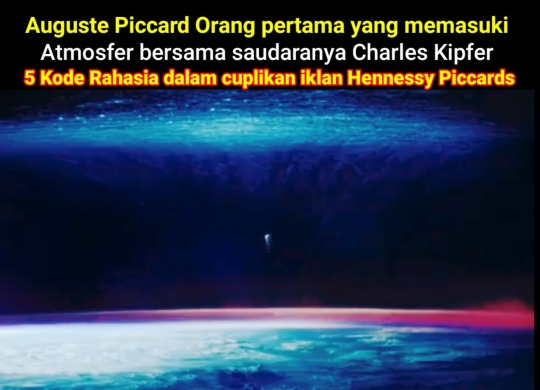
View On WordPress
#Alur cerita film Hennessy"The Piccards#Film Auguste Piccard Sub indo#Film Hennessy The Piccards Sub indo#Film Kubah Bumi datar Hennessy"The Piccards
0 notes
Text
Birthdays 1.28
Beer Birthdays
John Goetz Jr. (1855)
H.P. Bulmer (1867)
Jean-Marie Mack (1948)
Shane McNamara (1989)
Five Favorite Birthdays
Alan Alda; actor (1936)
Barbie Benton; model, singer (1950)
Claes Oldenburg; artist (1929)
Robert Stroud; "Birdman of Alcatraz" (1890)
Robert Wyatt; rock musician (1945)
Famous Birthdays
Thomas Aquinas; religious writer (1225)
Johann Ernst Bach; composer (1722)
John Barclay; French-Scottish poet & author (1582)
John Barley; poet (1582)
Marthe Bibesco; Romanian-French author & poet (1886)
Acker Bilk; clarinetist (1929)
Marcel Broodthaers; Belgian painter and poet (1924)
William Seward Burroughs; inventor (1857)
Ernest William Christmas; Australian-American painter (1863)
Roy Clarke; English screenwriter, comedian (1930)
Colette; French novelist and journalist (1873)
Frank Darabont; film director (1959)
Sidonie-Gabrielle Colette; French writer (1873)
Bill Doak; St. Louis Cardinals P (1891)
Ernie; character on Sesame Street
Joey Fatone; singer, dancer, & tv personality (1977)
Jack Hill; film director and screenwriter (1933)
Robert W. Holley; biochemist (1922)
Tom Hopper; English actor (1985)
Susan Howard; actor (1944)
Ismail Kadare; Albanian novelist, poet & playwright (1936)
Tomas Lindahl; Swedish-English biologist (1938)
David Lodge; English author and critic (1935)
José Martí; Cuban journalist, poet & theorist (1853)
Derrick Mayes; Green Bay Packers WR (1974)
Sarah McLachlan; singer, composer (1968)
Kathryn Morris; actress (1969)
Bob Moses; drummer (1948)
Alice Neel; artist (1900)
Per Oscarsson; Swedish actor, director & screenwriter (1927)
John Perkins; writer (1945)
Sam Phillips; record producer (1923)
Sam Phillips; singer-songwriter and guitarist (1962)
Auguste Piccard; Swiss physicist & explorer (1884)
Jackson Pollock; artist (1912)
Gregg Popovich; basketball player (1949)
Rick Ross; rapper and producer (1976)
Artur Rubenstein; pianist (1887)
Johann Elias Schlegel; German poet & critic (1719)
Ronnie Scott; jazz saxophonist (1927)
Frank Skinner; English comedian, actor, & author (1957)
Vladimir Solovyov; Russian philosopher, poet (1853)
Susan Sontag; writer (1933)
Henry Morton Stanley; explorer (1841)
John Tavener; English composer (1944)
Dick Taylor; rock musician (1943)
Ludolph van Ceulen; German-Dutch mathematician (1540)
Christian Felix Weiße; German poet & playwright (1726)
Gregor Werner; Austrian composer (1693)
Vera Williams; author and illustrator (1927)
Ariel Winter; actress (1998)
Jim Wong-Chu; Canadian poet (1949)
Elijah Wood; actor (1981)
0 notes



